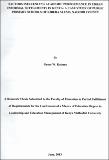| dc.description.abstract | The study set to establish the factors influencing academic performance in urban informal settlements: a case study of Kibera slums in Lang'ata District of Nairobi County. In spite of the government's commitment to provision of universal Free Primary Education (FPE) to all children that have attained school going age, there are segments of the society which continue to face myriad of hurdles in access of and participation in basic education key amongst these are children in the slums. The dimensions of these hurdles include; high pupil teacher ratios, inadequate learning materials, and limited admissions spaces due to fewer schools. Though these challenges exist in public primary schools, they are more pronounced in schools located in the informal settlements. This study was carried out in public primary schools located in Kibera slums of Nairobi County. The research employed the descriptive survey design. Four public primary schools found in Kibera slums and the head teachers were sampled purposively using the purposive sampling technique. Nine teachers and eighty two class eight pupils from these schools were sampled using the simple random sampling technique. The study used questionnaires for head teachers, teachers and pupils as the research tools. Reliability of the tools were guaranteed by a test-retest method, a pilot study was carried out in the neighboring Dagoretti district. This helped the researcher to identify questions that were ambiguous. Content validity was ensured by including as many questions as possible for each variable under investigation. Data collected was analyzed quantitatively and qualitatively. Data from open ended questions was analyzed using SPSS version 18 and Spread Sheets (MS Excel). Findings were presented in tables as well as bars and pie charts. Descriptive statistics was used to describe the sample. The responses obtained were presented in order of relative importance according to the objectives of the study. The study came up with the following findings: Most pupils came from poor backgrounds. Such backgrounds meant that parents could not afford decent housing and good sanitary facilities for their children. The majority of the families where pupils came from lived in single mud and iron sheet houses. All the respondents pointed out that academic level of parents was correlated to the performance of pupils in exams. All in all, it was evident that families in the slums lived on meagre incomes and could not afford all the necessary needs of pupils. There was also much pressure on learning facilities due to high pupil teacher ratio. In the school environment, poor facilities and existence of various social evils affected the psychological state of pupils. This in itself affected the performance of pupils in examinations.The study fulfilled the expected objectives. It was established that there were various socio-economic, psychological and environmental factors that affected the performance of pupils in urban informal settlements. | en_US |

